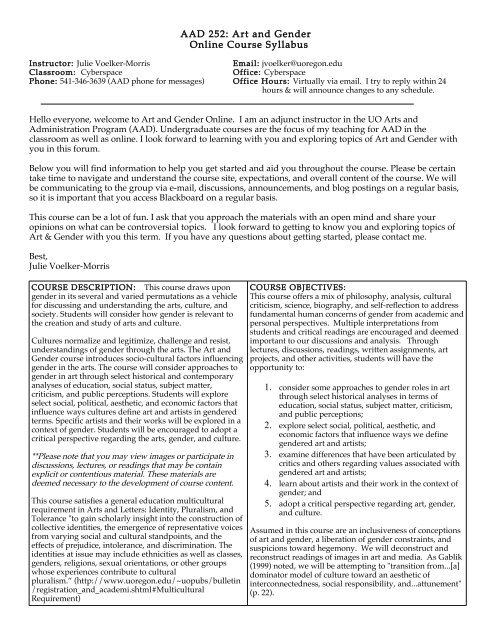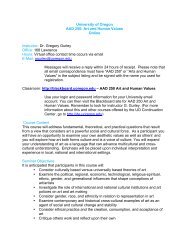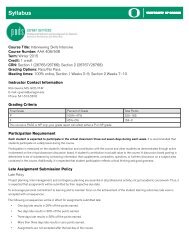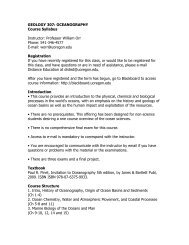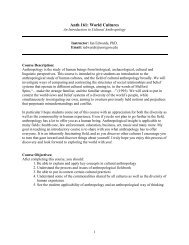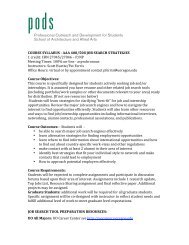Course Syllabus - University of Oregon
Course Syllabus - University of Oregon
Course Syllabus - University of Oregon
You also want an ePaper? Increase the reach of your titles
YUMPU automatically turns print PDFs into web optimized ePapers that Google loves.
AAD 252: Art and GenderOnline <strong>Course</strong> <strong>Syllabus</strong>Instructor: Julie Voelker-MorrisEmail: jvoelker@uoregon.eduClassroom: CyberspaceOffice: CyberspacePhone: 541-346-3639 (AAD phone for messages) Office Hours: Virtually via email. I try to reply within 24hours & will announce changes to any schedule.Hello everyone, welcome to Art and Gender Online. I am an adjunct instructor in the UO Arts andAdministration Program (AAD). Undergraduate courses are the focus <strong>of</strong> my teaching for AAD in theclassroom as well as online. I look forward to learning with you and exploring topics <strong>of</strong> Art and Gender withyou in this forum.Below you will find information to help you get started and aid you throughout the course. Please be certaintake time to navigate and understand the course site, expectations, and overall content <strong>of</strong> the course. We willbe communicating to the group via e-mail, discussions, announcements, and blog postings on a regular basis,so it is important that you access Blackboard on a regular basis.This course can be a lot <strong>of</strong> fun. I ask that you approach the materials with an open mind and share youropinions on what can be controversial topics. I look forward to getting to know you and exploring topics <strong>of</strong>Art & Gender with you this term. If you have any questions about getting started, please contact me.Best,Julie Voelker-MorrisCOURSE DESCRIPTION: This course draws upongender in its several and varied permutations as a vehiclefor discussing and understanding the arts, culture, andsociety. Students will consider how gender is relevant tothe creation and study <strong>of</strong> arts and culture.Cultures normalize and legitimize, challenge and resist,understandings <strong>of</strong> gender through the arts. The Art andGender course introduces socio-cultural factors influencinggender in the arts. The course will consider approaches togender in art through select historical and contemporaryanalyses <strong>of</strong> education, social status, subject matter,criticism, and public perceptions. Students will exploreselect social, political, aesthetic, and economic factors thatinfluence ways cultures define art and artists in genderedterms. Specific artists and their works will be explored in acontext <strong>of</strong> gender. Students will be encouraged to adopt acritical perspective regarding the arts, gender, and culture.**Please note that you may view images or participate indiscussions, lectures, or readings that may be containexplicit or contentious material. These materials aredeemed necessary to the development <strong>of</strong> course content.This course satisfies a general education multiculturalrequirement in Arts and Letters: Identity, Pluralism, andTolerance "to gain scholarly insight into the construction <strong>of</strong>collective identities, the emergence <strong>of</strong> representative voicesfrom varying social and cultural standpoints, and theeffects <strong>of</strong> prejudice, intolerance, and discrimination. Theidentities at issue may include ethnicities as well as classes,genders, religions, sexual orientations, or other groupswhose experiences contribute to culturalpluralism.” (http://www.uoregon.edu/~uopubs/bulletin/registration_and_academi.shtml#MulticulturalRequirement)COURSE OBJECTIVES:This course <strong>of</strong>fers a mix <strong>of</strong> philosophy, analysis, culturalcriticism, science, biography, and self-reflection to addressfundamental human concerns <strong>of</strong> gender from academic andpersonal perspectives. Multiple interpretations fromstudents and critical readings are encouraged and deemedimportant to our discussions and analysis. Throughlectures, discussions, readings, written assignments, artprojects, and other activities, students will have theopportunity to:1. consider some approaches to gender roles in artthrough select historical analyses in terms <strong>of</strong>education, social status, subject matter, criticism,and public perceptions;2. explore select social, political, aesthetic, andeconomic factors that influence ways we definegendered art and artists;3. examine differences that have been articulated bycritics and others regarding values associated withgendered art and artists;4. learn about artists and their work in the context <strong>of</strong>gender; and5. adopt a critical perspective regarding art, gender,and culture.Assumed in this course are an inclusiveness <strong>of</strong> conceptions<strong>of</strong> art and gender, a liberation <strong>of</strong> gender constraints, andsuspicions toward hegemony. We will deconstruct andreconstruct readings <strong>of</strong> images in art and media. As Gablik(1999) noted, we will be attempting to "transition from...[a]dominator model <strong>of</strong> culture toward an aesthetic <strong>of</strong>interconnectedness, social responsibility, and...attunement"(p. 22).
COURSE STRUCTURE and MEETING TIMES:Because this is an on-line class, we will not meet as a group,but rather asynchronously as our geographical locationsand personal daily schedules allow. This gives you time toplan your weekly schedule as needed to prepare for andmeet the weekly deadlines. **Please note that during someweeks, your schedule planning for this course should makeroom for participation in interactive graded discussionsthroughout that specific week.General Information about the course is listed under"<strong>Course</strong> Information" and "Staff Information." It is <strong>of</strong>particular importance to pay attention to the <strong>Course</strong>Schedule document included under "<strong>Course</strong> Information".This document outlines all course themes and assignmentson a week-to-week basis. Readings, assignments, andsupplemental materials will be posted on a weekly basisunder the course Blackboard navigation button titled,"<strong>Course</strong> Documents”. Students are expected to completeassignments including online dialogue and individualactivities for specified due dates. Review the <strong>Course</strong>Schedule under the “<strong>Course</strong> Information" link for specificdeadlines.The course is divided by sessions that will each have anarts, gender, and culture theme. Themes are chosen toprovide various perspectives while navigating throughinformation from this rich, controversial, and constantlychanging area <strong>of</strong> study. Themes may include: Language,Images, Contexts; Gender Portrayals; The Idea <strong>of</strong> the Gaze;Selling Gender, Race, and Class; Arts, Sports & Gender;Accessibility, Marginalization & Belonging; Erotica,Pornography & Obscenity; Constructing Gender ThroughFashion; Customizing the Body; Gendered Landscapes;Gendered Collaboration.Shared Responsibilities in a Learning Community(adapted from J. Batterson, 2004): Multiple interpretationsand ideas from participants in this course are welcome andencouraged. All members <strong>of</strong> the learning community (i.e.,our class) share the responsibilities <strong>of</strong> gathering,synthesizing, and building meaning from information.As your instructor, I am responsible to:a) give you control over your own learning within theboundaries <strong>of</strong> the course purpose and outcomesb) help you establish quality criteria for your workc) help you believe you can achieve successd) demonstrate the value <strong>of</strong> this coursee) help you access quality resources, clarify conceptsf) guide you in completing tasks to demonstrate yourachievementg) affirm your achievement with youCOMMUNICATIONSPlease note that all email correspondence should have"AAD 252" or "Art and Gender" in the subject listing and besigned with the name you used for registration. This allowsus to make emails regarding courses we participate in <strong>of</strong>priority to other correspondence we receive.To communicate most effectively, please include specificquestions you have about an assignment, course structure,or other topic you may want to address. When you attachassignment documents, please include your name and theassignment name in the file name (ex:"voelker_week7.doc").Announcements will be posted via email and on thehomepage <strong>of</strong> our course site; this is the main interface pagefor <strong>Course</strong> Information. Occasionally, events or articles <strong>of</strong>interest related to course themes will be forwarded viaemail. You will find additional tools and resources under"Student Tools" and "Resources."GENERAL EXPECTATIONS:I anticipate that you will:Visit the Blackboard site and participate in classdiscussions, assignments, etc. on a regular basis.Contribute your engaged and critical thoughts andperspectives on our weekly topics.Spend 8-12 hours a week on readings, lectures,discussion board, and assignments, just as would beexpected in a course meeting face-to-face.Complete all assigned work. If you do not completeall assigned work, you will not be eligible for an "A" inthis class (regardless <strong>of</strong> your point total).Review the discussion and essay rubrics andsuggestions under the “<strong>Course</strong> Information" sectionfor more information about grading expectations.Include your last name in submitted files (ex:"smith_final.pdf") as it makes it simpler for all <strong>of</strong> us toknow who prepared the work we are reading.Class Conduct: Material presented in this course can becontroversial or involve contentious discussion. A variety<strong>of</strong> opinions and ideas are encouraged and appreciated.Participation in this class assumes that:a) dignity and essential worth <strong>of</strong> participants is respected.b) privacy, property, and freedom <strong>of</strong> all participants will berespected.c) bigotry, discrimination, violence, and intimidation willnot be tolerated.d) personal and academic integrity is expected.PARTICIPATIONParticipation in discussions and weekly activities isessential to individual learning and group processes <strong>of</strong> thecourse. Discussions and activities are intertwined withpresentation/discussion materials as key components <strong>of</strong>individual and collective learning in this course.As a student, you are responsible for your own learning by:a) openly sharing your work and asking for feedbackb) relating concepts and skills to real world experiencesc) gathering & synthesizing information <strong>of</strong> varying sourcesd) making us aware <strong>of</strong> your individual learning needse) being prepared and on time for all <strong>of</strong> our sessionsWhen participating, be present and engaged in the materialand work at hand. Participation will be monitored basedupon active participation in class discussions and activitiesrevolving around weekly course topics. The instructorreserves the right to drop a student's course grade oneletter grade for every three (3) absences in the course.
<strong>Course</strong> Requirements:1. Weekly class participation. Attendance for the class willbe monitored through weekly discussion and assignments.For every three (3) absences, the instructor reserves theright to lower your overall course grade by one lettergrade.2. Completion <strong>of</strong> weekly readings and assigned discussionsand activities.3. Completion <strong>of</strong> midterm.<strong>Course</strong> Assignments for Evaluation: All courseassignments are outlined on our course Blackboard site. Thecourse is divided into four major areas <strong>of</strong> evaluation:1. Activities/Participation -- Thoughtful responses toreadings, participation in activities, peer work, anddiscussions ---100points2. Midterm Essay -- A gendered critique <strong>of</strong> an artist’s workthrough an academic essay -- 100 points3. Final Project -- Hands-on art activity exploring one issue<strong>of</strong> gender - 100 points4. Completion <strong>of</strong> the final project.NOTES ON GRADING:Please complete all assigned work. If you do not completeall assigned work, you will not be eligible for an "A" in thisclass regardless <strong>of</strong> your point total.GRADING SCALEDescription Individual pts. Total for termClass activities /discussions 10pts/week 100Midterm essay 100 100Final project 100 100Total: 300 300Extra Credit: Extra credit assignments are usually not<strong>of</strong>fered. If there is an exception, it will be announced laterin the term.Late Assignments: Late assignments are negotiablewith the instructor or GTF. It is the student's responsibilityto contact us about the possibility <strong>of</strong> turning in anassignment for late credit. Late assignments will not beaccepted without prior arrangement. Assignments will notbe accepted after the last day <strong>of</strong> classes for the term.Grading for late assignments is one letter grade lower foreach week they are late. Example: If you would havereceived a "B" on an assignment, but it was submitted aweek late, it will be given a "C"; if turned in two weeks late,a "D" would be assigned.Final course grades (out <strong>of</strong> a total 400 points) Pluses andminuses as per the <strong>University</strong> grading scale will be utilized.The A+ option is given only for extremely outstandingassignments and participation throughout the entire term.The instructor reserves the right to drop a student's coursegrade one letter grade for every three (3) absences in thecourse.Requesting an Incomplete: An incomplete may beissued when the quality <strong>of</strong> work is satisfactory, but someminor yet essential requirement has not been completed, forreasons acceptable to the instructor. The student will beresponsible for requesting an incomplete for a course andnegotiating a contract with the faculty member to completethe course requirements. An incomplete is granted at thediscretion <strong>of</strong> faculty and only with a signed contract. Thestudent is responsible for meeting the terms <strong>of</strong> this contractby the agreed-upon deadline. The faculty member isresponsible for ensuring that a grade is reported after allwork to fulfill this contract is completed.Grade Disputes: Should you wish to dispute a gradereceived, please wait to respond to the grade for 24 hours.Then, please write and submit a detailed response outliningyour dispute <strong>of</strong> the assigned grade. If we are unable to reachan agreement, the next step is for us to transfer the issue toadministrative faculty with the AAD Program. Theadministrative faculty member will attempt to resolve thedispute. If no resolution is reached, you will be informed <strong>of</strong>the next step in the university's appeals process for studentsin all courses.PARTICIPANTS WITH DISABILITIES: The UO is working to create inclusive learning environments. If there areaspects <strong>of</strong> the instruction or design <strong>of</strong> this course that result in barriers to your participation, please notify the instructoras soon as possible. You are welcome to contact Disability Services, 164 <strong>Oregon</strong> Hall; 346-1155 or disabsrv@uoregon.edu.Disabilities may include (not limited to) neurological, hearing, visual, or orthopedic impairment; chronic medicalconditions; and psychological or learning disabilities.ABSENCES: If you have a planned absence, please contact me in advance so that we can work together around thesituation. The instructor reserves the right to drop a student's course grade one letter grade for every three (3) absencesin the course.Exceptional Emergency Situations -- The following are unforeseen/uncontrollable, exceptional emergency situationsthat are acceptable excuses for missing assignment deadlines without penalty and issuance <strong>of</strong> incomplete (I) finalgrades at the end <strong>of</strong> the course:* Acceptable: Documented serious illness/injury; death in the immediate family; pregnancy issues; court subpoena.You can received up to full credit on an assignment for these types <strong>of</strong> absences.
* Unacceptable: Weddings; family visits/reunions, family/spring vacation, special occasions; unable to retrieve filefrom hard drive/disk/etc; dental/medical appointments; work, family/personal/school conflicts; being generallybusy/”I have a lot going on right now”/”I’ve been really busy this week”; “the syllabus is unclear”, “I was confused/unsure when the assignment was due”; transportation issues: flat tire, traffic back-up etc. You can receive only partialcredit for these types <strong>of</strong> absences.COURSE TEXTSE-reserves: Most course readings are available through theE-reserve program <strong>of</strong> the UO Libraries. These articles areavailable in electronic format only through the <strong>University</strong><strong>of</strong> <strong>Oregon</strong> Library. You must access the E-reserves directlythrough Blackboard. The link and term user name andpassword information is under the <strong>Course</strong> Documentslink.Other materials are web accessible via our courseBlackboard site or ones that you search for specific toassignments.Recommended text available at the UO DuckStore:Leppert, R. (2007). The Nude: The Cultural Rhetoric <strong>of</strong>the Body in the Art <strong>of</strong> Western Modernity. Boulder CO:Westview Press.CREATIVE MATERIALSYou may additionally be asked to use supplies for creativeprojects. Such materials may include digital or film camera,scissors, glue, paper, magazines, stickers, buttons, string,thread, items found in nature, fabric scraps, pencils,crayons, inks, laptops or other sources to use online ors<strong>of</strong>tware tools, etc.A note on readings: The reading load in this course is fairlyheavy. I believe this is essential and important for us tohave a variety <strong>of</strong> resources and perspectives to draw from. Ido not expect that you will know the reading materialsword-for-word. I do, however, expect that you understandthe basic concepts and theories presented well enough toincorporate them effectively into assignments and coursediscussions.THE DISCUSSION BOARD and STUDENT BLOGS:The Discussion Board and Student Blogs are integral parts<strong>of</strong> the course design. All assignments are submittedthrough the discussion board or blog interfaces. Even morespecifically, the discussion board and blogs are the center<strong>of</strong> our interactions with one another in the course as themost "live" portion <strong>of</strong> our class.The discussion boards and blogs are meant as forums toshare informed ideas and opinions about the readings andcourse content. Therefore, students will earn the mostpoints on the Discussion Boards/Blogs if they consider thefollowing within posts. (Some <strong>of</strong> these statements are moreapplicable to discussions than blogs but are intertwined inthe idea <strong>of</strong> active participation and informed responses.)Some ways to go about posting could be:1. Asking the group questions or posting comments youhave about the readings2. Replying directly to questions/comments presented byothers in the class3. Referring us to specific imagery, ideas, examples withcomments/questions that build upon the specific topic area4. Sharing examples or ideas from your fields <strong>of</strong> interestand experience that may leads to additional lines <strong>of</strong>questioning and thinking for the week.5. Replying to others' posts in a posting that may notdirectly be part <strong>of</strong> the original posts' thread. (this showsyou are following the conversation and connecting it in avariety <strong>of</strong> ways)6. Other ways that you can think <strong>of</strong>.a) actively participate, responding thoughtfully to the topicarea and to peers' responses throughout a designateddiscussion period. Go beyond simple, "I agree with..."statements (see 'Academic Discourse' below for more).b) integrate specific elements <strong>of</strong>/direct references to thereadings or lecture materials into their posts/responsesc) introduce new topic threads through questions, thoughtsfor further discussion, previously unmentioned thoughtsabout the readings or lecture materials and/or posteddiscussion questions;d) respond multiple times throughout a given discussion.Multiple postings late in the discussion period are notweighted as heavily as those posted throughout discussionas the means to develop ideas through dialogue; ANDe) Actively participate throughout the designated time,early, frequently, with depth <strong>of</strong> thought. (See rubric)Posting Assignments for Instructor/Peer Review:In general, please submit the full body <strong>of</strong> your work withina blog or discussion post. All assignments should besubmitted in the designated discussion board or blog.Occasionally, assignments will need to be submitted in afile format. When this is necessary, please include your lastname in submitted files to simplify knowing whoprepared the work we are reading. Example"voelkermorris_Wk9.doc". Please submit assignments inthe following formats whenever possible:"doc" (Word Document), "rtf" (text file), "txt" (text file),"pdf" (portable document file), html" (hypertext),"ppt" (PowerPoint file), “jpg” (image file)If your file is in another format, please let me know inadvance so that I can make certain I have access to thes<strong>of</strong>tware or we can find another way for you to post it.
ACADEMIC DISCOURSE (For assignments inthis course; adapted from R. Voelker-Morris, 2008):As with any academic forum <strong>of</strong> research anddiscourse, there are certain expectations for the waysin which a student approaches the course materials.This means that we move beyond the personal andinformal discussion found in daily venues. Studentsshould incorporate critical thinking in their work by:Framing a central question or argument that isthen backed up with proper evidence <strong>of</strong> topicknowledge. Includes original thinking aboutpossible answers to the question/argument(even if this means you may later re-frame andchange your first posed question/argument).Analyzing all topics presented by the instructorand other students in a critical fashion, goingbeyond simple (dis)agreeing statements.Interpreting connections between multipletopic areas and/or author arguments to formnew insights into the materials covered.Researching and applying outside resources tosupport arguments and statements andresearch sources that demonstrate the student isversed in the literature about the topic areas.Classifying the topics and sources into easy tounderstand descriptions <strong>of</strong> concepts presented.Articulating thoughts, arguments, topicconnections, sources, and other statements intoa cohesive and detailed writing or presentationformat in which proper grammar and writingstructures allow for easy understanding <strong>of</strong> eventhe most complex <strong>of</strong> ideas.Posing questions to the learning community forfurther consideration and research.This encompasses Critical Thinking. If you feel thatyour thoughts are not being understood by coursecolleagues, review these descriptions and apply themto your work within assignments (see Elements &Standards Model at www.criticalthinking.org/courses/Elements_standards_model.cfm).A well cultivated critical thinker:raises vital questions and problems, formulatingthem clearly and precisely;gathers and assesses relevant information, usingabstract ideas to interpret it effectively, coming towell-reasoned conclusions and solutions, testingthem against relevant criteria and standards;thinks open-mindedly within alternative systems <strong>of</strong>thought,recognizes and assesses, as need be, one'sassumptions, implications, and practicalconsequences;communicates effectively with others in figuringout solutions to complex problems.ACADEMIC HONESTY (adapted from J.Rutherford, 2005 and Southwestern CollegeIntegrative Studies Program, 1999):Plagiarism is a serious <strong>of</strong>fense. The consequences forusing the words <strong>of</strong> another without quotation marksor citation, or <strong>of</strong> using the ideas and conclusions <strong>of</strong>another without citation, are severe. In this course,such academic dishonesty will not be tolerated andmay be grounds for automatic failure on a givenassignment. Penalties may range from having torewrite an assignment, to failing the assignment, t<strong>of</strong>ailing the course.In a basic definition, plagiarism is borrowing others'words and ideas without proper acknowledgment. Ifone <strong>of</strong> your motivations for going to college is to get agood job, then you need to be able to research, think,and write on your own while giving credit to sourcesthat inspire, inform, or otherwise provide you withstatistics, ideas, etc. Gathering information andlearning from others' knowledge means you havedone your homework.The perspectives <strong>of</strong> others should enhance andsupport your research, thinking, and writing. Others'opinions should not take the place <strong>of</strong> your opinionbut emphasize its validity. Your synthesis or analysis<strong>of</strong> the topic will more likely be accepted as valid if theassignment shows you have done your research.Classroom practice assists skills in the work world.References need to be cited whenever used within thebody <strong>of</strong> the written assignment. When using 3 ormore words in a row from another author/source,they must be placed in quotation marks and cited --quote them exactly. You should also cite ideas(including summaries and paraphrases) you usefound in the work <strong>of</strong> another author/source that arenot your original work or which fall under the realm<strong>of</strong> common knowledge. Paraphrasing should bewritten in your own language and style. Also includea References/Works Cited page at the end <strong>of</strong> anywritten assignment so that references may be foundby any reader for further information. If it is foundthat you have copied work from others, withoutcredit, your work is more likely to be rejected.If you have questions about citing sources, pleasecontact me, consult the advisors at the Writing Lab inPLC, or use a writing guide from the library.Citation styles include:APA: http://apastyle.apa.org/MLA: http://www.mla.org/styleChicago:www.chicagomanual<strong>of</strong>style.org/home.htmlYou may Google styles listed above for other guides.Further information regarding academic dishonesty:http://libweb.uoregon.edu/guides/plagiarism/students/. Student Conduct Code:http://studentlife.uoregon.edu/judicial/conduct/code.htm.
“Critical thinking is, in short, self-directed, selfdisciplined,self-monitored, and self-correctivethinking. It presupposes assent to rigorousstandards <strong>of</strong> excellence and mindful command <strong>of</strong>their use. It entails effective communication andproblem solving abilities and a commitment toovercome our native egocentrism andsociocentrism.” (Scriven, M., & Paul, P. Retrieved fromhttp://www.criticalthinking.org/aboutCT/definingCT.cfm)Why you should cite sources (L. Ettinger, 2003):1. Demonstrate knowledge <strong>of</strong> the work to others;2. Build upon others' ideas, extending knowledge;3. Allow others to analyze your work in relation to alarger body <strong>of</strong> material;4. Document your theoretical and practicalperspectives;5. Define your context and terms;6. Join a learning community;7. I'm sure you and others can add to this list.USE OF IMAGES: Images posted on Blackboardare available for use in this format under aneducational fair use policy. This policy requires thatthey be used for educational purposes only.Therefore, to protect images from copyrightinfringement, students should not download or alterimages in any way.ASSIGNMENT RETAINMENT POLICY:Assignments for this course will not be kept longerthan current university policy requires, that is, onlyone quarter after the course has occurred. After thattime, the instructor will take any remainingassignments to university shredding services, deletethem from hardware or s<strong>of</strong>tware files, or otherwisedispose <strong>of</strong> them at the instructor's discretion.ARTS & ADMINISTRATION (AAD) PROGRAMDESCRIPTION: Arts management is a multidisciplinaryfield, focused on promoting the arts and culture forindividuals and societies. Knowledge and expertise fromthe arts is combined with social, cultural, managerial, andeducational perspectives for the purpose <strong>of</strong> creating,implementing, and administering cultural programs innon-pr<strong>of</strong>it, for-pr<strong>of</strong>it, and unincorporated organizationsand institutions.Constituents served by AAD include graduate students inarts management, undergraduate community arts minors,undergraduates fulfilling arts & letters and/ormulticultural requirements, and arts pr<strong>of</strong>essionals. Artsmanagement at the UO is characterized by a commitmentto a multicultural and socio-political orientation to art andculture; a strong belief in electronic communication andopportunities afforded by the Internet; a focus oncontemporary and future trends; and a belief in theimportance <strong>of</strong> research to the pr<strong>of</strong>ession.If you have interest in the Community Arts minor, I wouldbe glad to talk about it with you as well as direct you to theminor program coordinator, Lori Hager, atlhager@uoregon.edu. To learn more about the program,you can visit http://aad.uoregon.edu/index.cfm?mode=programs&page=minorSCHOOL OF ARCHITECTURE & ALLIED ARTS(AAA) DESCRIPTION: AAA is dedicated to advancingthe understanding, value, and quality <strong>of</strong> visual culture andthe built, natural, and social environments throughexcellent and distinctive teaching, research, and creativeendeavors. Grounded in a unique multi-disciplinarystructure, AAA is a diverse, collegial learning community<strong>of</strong> faculty, students, and staff. We seek to enhance the lives<strong>of</strong> individuals and communities through endeavors thatstem from intellectual curiosity, critical thinking, and broadinquiry, rooted in the inter-relatedness <strong>of</strong> theory, history,and practice. In support <strong>of</strong> this mission, AAA affirms thefollowing values:a) Excellence -- supporting and celebrating a culture thatpromotes rigor, encourages risk-taking, and challengesstandards in creating, composing, and presenting ideas.b) Open discourse -- Fostering the open exchange andcritique <strong>of</strong> ideas in an environment that welcomes adiversity <strong>of</strong> views.c) Inclusiveness -- Actively encouraging the presence andparticipation in the School <strong>of</strong> individuals with differingbackgrounds, experience, and world-views.d) Cooperation -- Working together in shared efforts toteach, learn, understand, and create.e) Inter-disciplinary Experience -- Engaging multipledisciplines to expand our perspective and enrich ourteaching, research, and creative practice.f) Responsibility -- Recognizing our accountability for theimpact <strong>of</strong> our actions on environmental, social, and culturalsystems.UO AFFIRMATION OF COMMUNITY STANDARDS:(http://policies.uoregon.edu/ch1affirmation.html) The<strong>University</strong> <strong>of</strong> <strong>Oregon</strong> community is dedicated to the advancement <strong>of</strong> knowledge and the development <strong>of</strong> integrity. Inorder to thrive and excel, this community must preserve the freedom <strong>of</strong> thought and expression <strong>of</strong> all its members. The<strong>University</strong> <strong>of</strong> <strong>Oregon</strong> has a long and illustrious history in the area <strong>of</strong> academic freedom and freedom <strong>of</strong> speech. A culture<strong>of</strong> respect that honors the rights, safety, dignity and worth <strong>of</strong> every individual is essential to preserve such freedom. Weaffirm our respect for the rights and well-being <strong>of</strong> all members.CAMPUS RESOURCES FOR STUDENTSBias Response Team http://bias.uoregon.edu/ (541)346-1134 or (541)346-1139, 164 <strong>Oregon</strong> Hall, brt@uoregon.eduCareer Center http://uocareer.uoregon.edu/ (541) 346-3235, 220 Hendricks Hall, career@uoregon.edu
Conflict Resolution Services http://studentlife.uoregon.edu/programs/crs/index.htm (541)346-0617 or (541)346-6105, lsponko@uoregon.edu (or) cmcgraw@uoregon.eduCounseling and Testing Center http://counseling.uoregon.edu/dnn/ (541) 346-3227 -- 2 nd Floor, <strong>University</strong> Health,Counseling, and Testing Center Building, 13 th & AgateCrisis Center http://www.uoregon.edu/~uocrisis/index.html (541) 346-4488, uocrisis@gladstone.uoregon.eduDisability Services http://ds.uoregon.edu/ (541)346-1155, 164 <strong>Oregon</strong> Hall, disabsrv@uoregon.eduDiversity Education & Support http://diversity.uoregon.edu/main.htm (541) 346-1139, 164 <strong>Oregon</strong> Hall,jrr@uoregon.eduHealth Center http://healthcenter.uoregon.edu/ (541) 346-2770, 1590 East 13 th Street,LGBT Educational and Support Services http://lgbt.uoregon.edu/ (541)346-1134, 164 <strong>Oregon</strong> Hall,program@uoregon.eduMen’s Center http://www.uoregon.edu/~uomc/ (541)346-0743, EMU Suite 2 (Lower level <strong>of</strong> the EMU),uomc@uoregon.eduNontraditional Student Programs (541)346-1123, 164 <strong>Oregon</strong> Hall, gjewett@uoregon.eduhttp://studentlife.uoregon.edu/programs/nontrad_student_prog/index.htmOffice <strong>of</strong> Multicultural Academic Support http://www.uoregon.edu/~omas/ (541)346-3479, 164 <strong>Oregon</strong> Hall,omainfo@uoregon.eduOffice <strong>of</strong> Student Life http://studentlife.uoregon.edu/main.htm (541)346-3216, 164 <strong>Oregon</strong> Hall, stl@uoregon.eduSexual Violence Prevention (541)346-1198, 164 <strong>Oregon</strong> Hall, aleeder@uoregon.eduhttp://studentlife.uoregon.edu/programs/sexual_violence_prev_edu/index.htmTeaching & Learning Center (Writing Lab, Math Lab, SAS) http://tlc.uoregon.edu/ (541)346-3226, 68 PrinceLucien Campbell Hall, tlc@uoregon.eduWomen’s Center http://www.uoregon.edu/~women/(541)346-4095, EMU Suite 2 (Lower level <strong>of</strong> the EMU), womenctr@uoregon.edu


